| written 5.6 years ago by |
Transmission of multimedia content over a high-speed network such as ATM for applications such as Video on Demand (Vod) is slated to become one of the fastest emerging applications in the real world.
Due to the low delay and high QoS (Quality of service) constraint posed by these applications, various issues arise such as selection of AAL (ATM Adaptation Layer), service class selection and others have to be addressed.
ATM is characterized by its ability to provide high QoS guarantees to multimedia applications. The classes of service: Constant Bit Rate (CBR), Available Bit rate (ABR), Real time Variable Bit rate (RT -VBR) and Unspecified Bit Rate (UBR) exist in ATM, which can be used to provide the required bit rate for multimedia applications
Video on Demand is a service wherein the video is transported over a network to be played at the customer premises The VoD system is shown in figure below:

Transport of Compressed Video over ATM the issues involving transport of compressed video over ATM are Selection of Service Class Adaptation Layer Selection of Service Class
Selection of Service Class
Video over ATM with CBR: To transmit video over CBR, the bit rate has to be negotiated first and is fixed during the length of the connection. In case of video the PCR has to be the same as the bit rate of the video . But due to video streams being bursty in nature, bandwidth is not utilized properly in CBR.
Video over ATM with ABR: One way of transmitting video over an ABR connection is to keep the output rate of the video encoder under control by using network feedback.
Video over ATM with VBR: In dealing with transporting video over ATM using VBR the following issues are dealt with
- Traffic shaping and Rate Control
- Bandwidth allocation/Management
- Congestion Control
- Buffer and Memory requirements
- Source Model and Behaviors
- Coding Technology
- Quality Control
Video over ATM using UBR: Since there is no feedback control the video stream is transported in a best effort manner similar to Internet Also, the flexible bandwidth renegotiation during transmission improves the network efficiency.
Selection of Adaptation Layer
AAL layer abstracts the network behavior from the applications. AAL1, AA2, AAL3/4 and AAL5 are the adaptation layers defined in the ATM standard
AAL1 was proposed for class A services and ca be used for applications such as circuit emulation services, constant bit-rate data, delivery at the same bit rate and transfer of timing information between sending and receiving applications
AAL5 is used for Class D services and it does not have any real time constraint. It can be used to transport VBR MPEG data.


 and 2 others joined a min ago.
and 2 others joined a min ago.